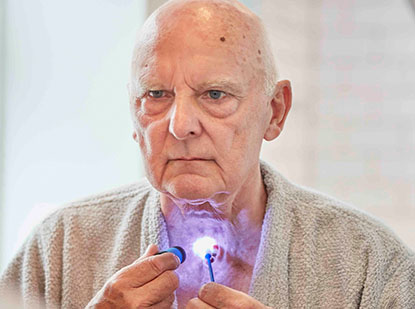Tips for voice prosthesis users
Is your voice prosthesis working as well as it should be? It can be helpful to learn some tips on recognising when it’s time to change your voice prosthesis.
Voice prostheses are not permanent implants. How long yours lasts depend on a number of factors.
If you notice any changes to your prosthesis or the surrounding tissue, you may require a replacement or a clinical check-up. By being alert and acting quickly if you notice something unusual, you can avoid problems later on.
- Consider contacting your clinician to ensure you are up to date with any changes to hospital recommendations for voice prosthesis changes.
- Know the type and size of your voice prosthesis and keep this information at hand.

1. Care for you voice prosthesis
From the moment your voice prosthesis is inserted, it will be exposed to naturally occurring bacteria and yeast. This will gradually break down the material of your voice prosthesis causing it to leak, look different or lose some of its functionality.
- Clean your voice prosthesis regularly with a brush, at least twice a day (in the morning and evening) and after each meal.
- Consider using a flush as a part of your cleaning routine. Make it a routine to brush first and then flush with warm water.
- Make sure the voice prosthesis brush and flush are always clean. Clean and rinse before and after each use.
2. Signs of leakage through your voice prosthesis
Leakage ‘through’ your prosthesis is the most common indication that you need to change your voice prosthesis. This happens when a build-up of bacteria and yeast stops the valve door from closing properly. You may notice coughing after swallowing or you may see signs of food-stained mucus.
- Make sure you have a voice prosthesis plug for your voice prosthesis that fits the type and size of voice prosthesis, in case it starts to leak.
Leakage ‘around’ your prosthesis could be a sign that the length of your voice prosthesis isn’t the right fit. You could also get a similar sort of leakage if there is a poor seal around your prosthesis.
3. Changes of colour or shape
The longer you have a voice prosthesis, the more likely it is to become discoloured or deformed. If you notice the appearance of your voice prosthesis starting to change significantly, then this is an equally valid reason to replace it.
Although a rare occurrence, you may experience granulation. This refers to extra tissue that can form as a result of irritation. The tissue may grow over your voice prosthesis. If you notice this contact your clinician to discuss what to do.
4. Dislodged voice prosthesis
If the tissue around your prosthesis is weak and not very flexible, the voice prosthesis may dislodge. This could happen after heavy coughing or a forceful cleaning of the prosthesis. If your voice prosthesis dislodges, follow the emergency procedures your clinician have given you and contact them immediately.
You should never hesitate to approach your clinicians – they are there for you.
Share